tow Citroen BERLINGO MULTISPACE 2015 2.G User Guide
[x] Cancel search | Manufacturer: CITROEN, Model Year: 2015, Model line: BERLINGO MULTISPACE, Model: Citroen BERLINGO MULTISPACE 2015 2.GPages: 298, PDF Size: 12.69 MB
Page 61 of 298

59
Berlingo-2-VP_en_Chap04_Ergonomie_ed01-2015
Screenwash and headlamp wash
Pull the stalk towards you, the wash-
wipe is accompanied by a timed sweep
of
the wipers.
The
headlamp wash is linked with the
wash-wipe, it is triggered if the dipped
headlamps
are on.
Turn
the ring past the first
position:
the rear screenwash
then the rear wiper operates
for
a fixed time.
In winter, in the event of a
considerable
amount of snow
or ice, switch on the heated
rear
screen. Once the screen is
clear
, remove the snow or ice which
has
accumulated on the rear wiper
blade.
Y
ou can then operate the rear
windscreen
wiper.
To top up the levels, refer to the
"Levels"
section of chapter 7.
Special position of the
windscreen wipers
In the minute following switching off of the ignition, any action on the
stalk
positions the wipers against the
windscreen
uprights.
This action enables you to position
the
wiper blades for winter parking,
cleaning
or replacement.
Refer to the "Changing a windscreen
wiper
blade" section of chapter 8.
To
park the wipers in their normal
position after this has been done,
switch
on the ignition and move the
stalk. T
urn the ring to the first
position.
Rear wiperRear screenwash
Steering mounted controls
EASE OF USE and COMFORT
4
Page 72 of 298
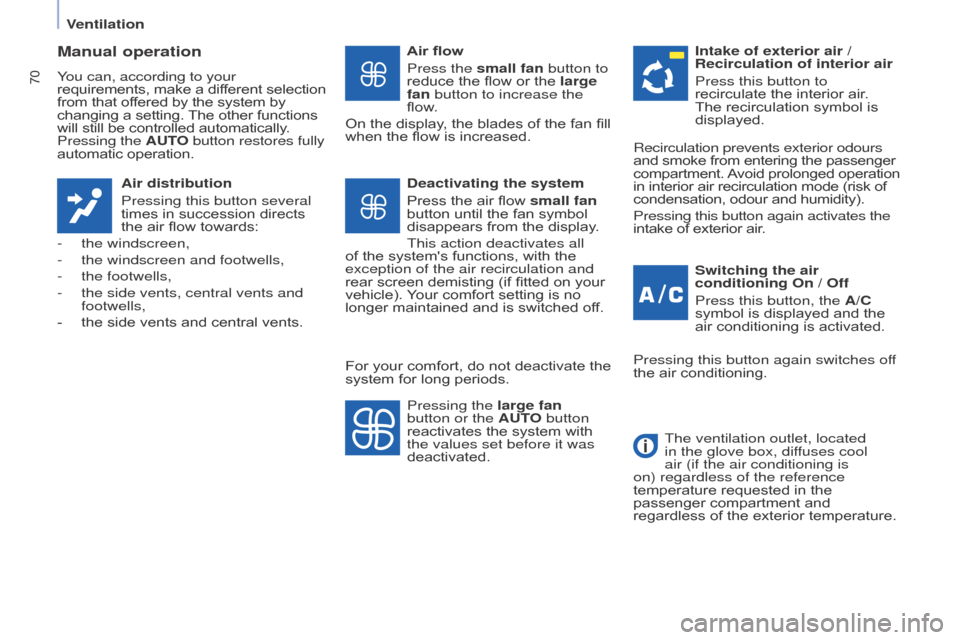
70
Berlingo-2-VP_en_Chap04_Ergonomie_ed01-2015Berlingo-2-VP_en_Chap04_Ergonomie_ed01-2015
Manual operation
You can, according to your
requirements, make a different selection from
that offered by the system by
changing
a setting.
The
other functions
will
still be controlled automatically.
Pressing the
AUTO button restores fully
automatic
operation.
Air distribution
Pressing this button several
times
in succession directs
the
air flow towards:
-
the windscreen,
-
the windscreen and footwells,
-
the footwells,
-
the side vents, central vents and
footwells,
-
the
side vents and central vents.Air flow
Press the small fan button to
reduce
the flow or the large
fan button to increase the
flow.
On
the display, the blades of the fan fill
when
the flow is increased.
Switching the air
conditioning On / Off
Press this button, the A/C
symbol
is displayed and the
air
conditioning is activated.
Deactivating the system
Press
the air flow small fan
button
until the fan symbol
disappears
from the display.
This action deactivates all
of
the system's functions, with the
exception of the air recirculation and
rear
screen demisting (if fitted on your
vehicle).
Y
our comfort setting is no
longer
maintained and is switched off.Intake of exterior air /
Recirculation of interior air
Press this button to
recirculate
the interior air.
The
recirculation symbol is
displayed.
Pressing the
large fan
button or the AUTO button
reactivates
the system with
the values set before it was
deactivated.Recirculation prevents exterior odours
and
smoke from entering the passenger
compartment.
A
void prolonged operation
in
interior air recirculation mode (risk of
condensation,
odour and humidity).
Pressing this button again activates the
intake
of exterior air.
Pressing this button again switches off
the
air conditioning.
The ventilation outlet, located
in the glove box, diffuses cool
air (if the air conditioning is
on) regardless of the reference
temperature
requested in the
passenger
compartment and
regardless
of the exterior temperature.
For
your comfort, do not deactivate the
system
for long periods.
Ventilation
Page 75 of 298
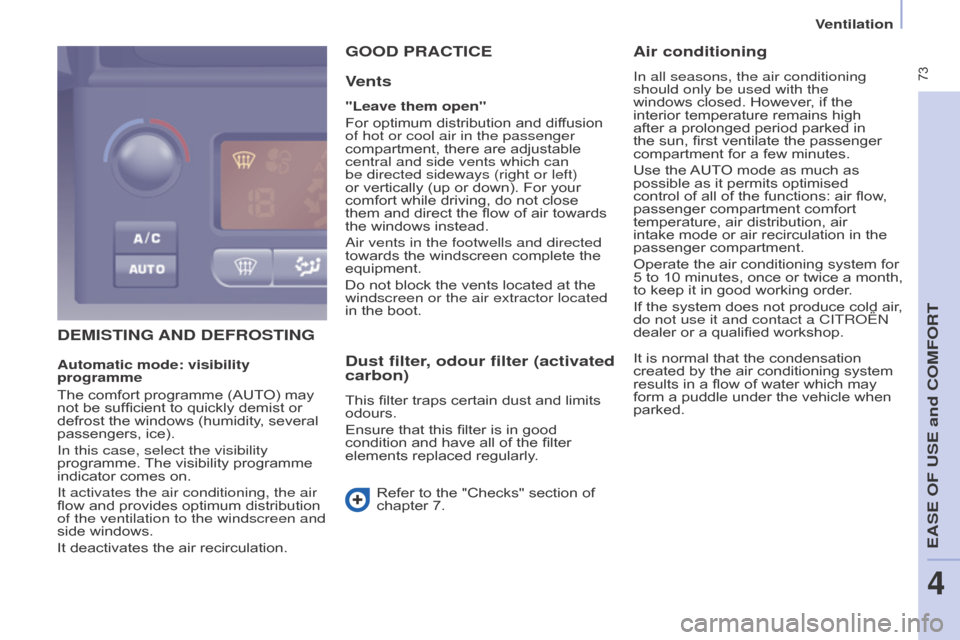
73
Berlingo-2-VP_en_Chap04_Ergonomie_ed01-2015Berlingo-2-VP_en_Chap04_Ergonomie_ed01-2015
DEMISTING AND DEFROSTING
G
OOD PRACTICE
V
ents
"Leave them open"
For
optimum distribution and diffusion
of hot or cool air in the passenger
compartment,
there are adjustable
central and side vents which can
be directed sideways (right or left)
or
vertically (up or down). For your
comfort
while driving, do not close
them
and direct the flow of air towards
the
windows instead.
a
ir vents in the footwells and directed
towards
the windscreen complete the
equipment.
Do
not block the vents located at the
windscreen or the air extractor located
in
the boot.
Dust filter, odour filter (activated
carbon)
This filter traps certain dust and limits odours.
Ensure that this filter is in good
condition
and have all of the filter
elements
replaced regularly.
Refer
to the "Checks" section of
chapter
7.
Air conditioning
In all seasons, the air conditioning
should only be used with the
windows closed. However, if the
interior
temperature remains high
after
a prolonged period parked in
the
sun, first ventilate the passenger
compartment
for a few minutes.
Use
the
AUT
O mode as much as
possible
as it permits optimised
control
of all of the functions: air flow,
passenger
compartment comfort
temperature,
air distribution, air
intake
mode or air recirculation in the
passenger
compartment.
Operate
the air conditioning system for
5
to
10
minutes,
once
or
twice
a
month,
to
keep it in good working order.
If
the system does not produce cold air,
do not use it and contact a CITR
o Ë n
dealer
or a qualified workshop.
Automatic mode: visibility
programme
The
comfort
programme
(AUTO)
may
not
be
sufficient
to
quickly
demist
or
defrost
the
windows
(humidity,
several
passengers,
ice).
In this case, select the visibility
programme.
The
visibility
programme
indicator
comes
on.
It activates the air conditioning, the air
flow
and
provides
optimum
distribution
of the ventilation to the windscreen and
side
windows.
It
deactivates
the
air
recirculation. It
is normal that the condensation
created
by the air conditioning system
results
in a flow of water which may
form
a puddle under the vehicle when
parked.
EASE OF USE and COMFORT
4
Ventilation
Page 88 of 298
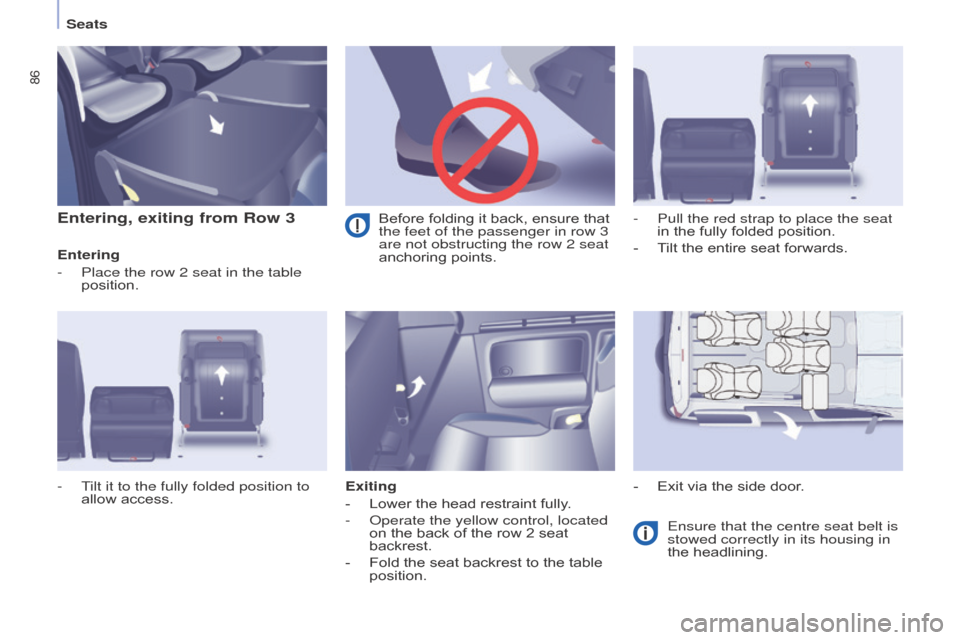
86
Berlingo-2-VP_en_Chap04_Ergonomie_ed01-2015Berlingo-2-VP_en_Chap04_Ergonomie_ed01-2015
Entering, exiting from Row 3
Entering
-
Place the row 2 seat in the table
position.
Exiting
-
Lower
the head restraint fully.
-
o perate the yellow control, located
on
the back of the row 2 seat
backrest.
-
Fold
the seat backrest to the table
position.Ensure that the centre seat belt is
stowed correctly in its housing in
the
headlining.
-
T
ilt it to the fully folded position to
allow
access. -
Pull the red strap to place the seat
in
the fully folded position.
- T ilt the entire seat forwards.
-
Exit
via the side door.
Before
folding it back, ensure that
the feet of the passenger in row 3
are not obstructing the row 2 seat
anchoring
points.
Seats
Page 90 of 298

88
Berlingo-2-VP_en_Chap04_Ergonomie_ed01-2015Berlingo-2-VP_en_Chap04_Ergonomie_ed01-2015
Operating the Row 3 seats
Removing the seat
-
Lower
the head restraint.
-
Place the seat in the fully folded
position.
-
T
ilt the entire seat forwards.
-
On
each side, take hold of the
uprights of the folded seat, tilting it
forward
slightly, and lift it.Refitting the seat
The label on the seat indicates the
position
in which it must be installed.
-
Place
the hooks of the front feet
between
the two bars.
-
Ensure
that no object or foot is
obstructing the rear anchorage
points and that the seat belt is
positioned correctly and available
for
use.
-
Fold
back the seat to fix its rear
anchoring
feet.
-
o perate the control to raise the
seat
back to its initial position.
-
Raise
the head restraint.
Good practice
Following the various operations:
-
do
not remove a head restraint
without stowing it; secure it inside
the vehicle,
-
ensure that the passengers can
always access the seat belts and
fasten
them easily,
-
passengers
must never take
their
seat without adjusting and
fastening
their seat belt.
-
a
passenger seated in row 3 must
ensure that he does not obstruct
the row 2 seat anchorage points,
-
a
passenger seated in row 3 must
not
have the seat in front of them in
row 2 in the folded position; this is
in case the seat could tip towards
the passenger unexpectedly and
injure
them.
Do
not place hard or heavy objects on
the
seat backs forming a table, they
could
become dangerous projectiles in
the
event or sharp braking or impact.
Seats
Page 101 of 298
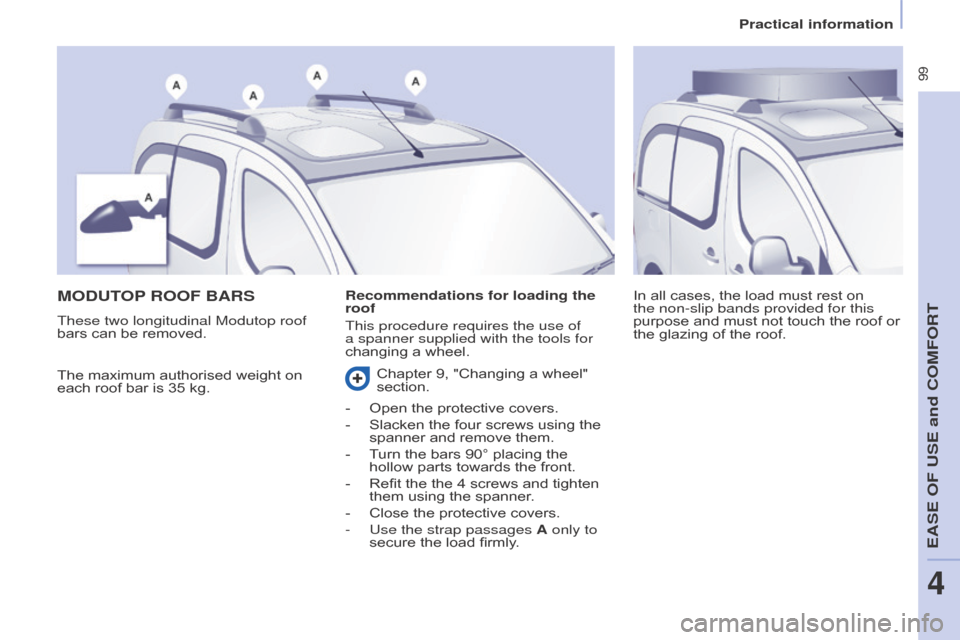
99
Berlingo-2-VP_en_Chap04_Ergonomie_ed01-2015Berlingo-2-VP_en_Chap04_Ergonomie_ed01-2015
MODUTOP ROOF BARS
The maximum authorised weight on each
roof bar is 35 kg. In
all cases, the load must rest on
the non-slip bands provided for this
purpose
and must not touch the roof or
the
glazing of the roof.
Recommendations for loading the
roof
This procedure requires the use of
a spanner supplied with the tools for
changing
a wheel.
These two longitudinal Modutop roof
bars can be removed.
Chapter 9, "Changing a wheel" section.
-
Open
the protective covers.
-
Slacken
the four screws using the
spanner
and remove them.
-
T
urn the bars 90° placing the
hollow
parts towards the front.
-
Refit
the the 4 screws and tighten
them
using the spanner.
-
Close
the protective covers.
-
Use the strap passages
A only to
secure
the load firmly.
EASE OF USE and COMFORT
4
Practical information
Page 104 of 298
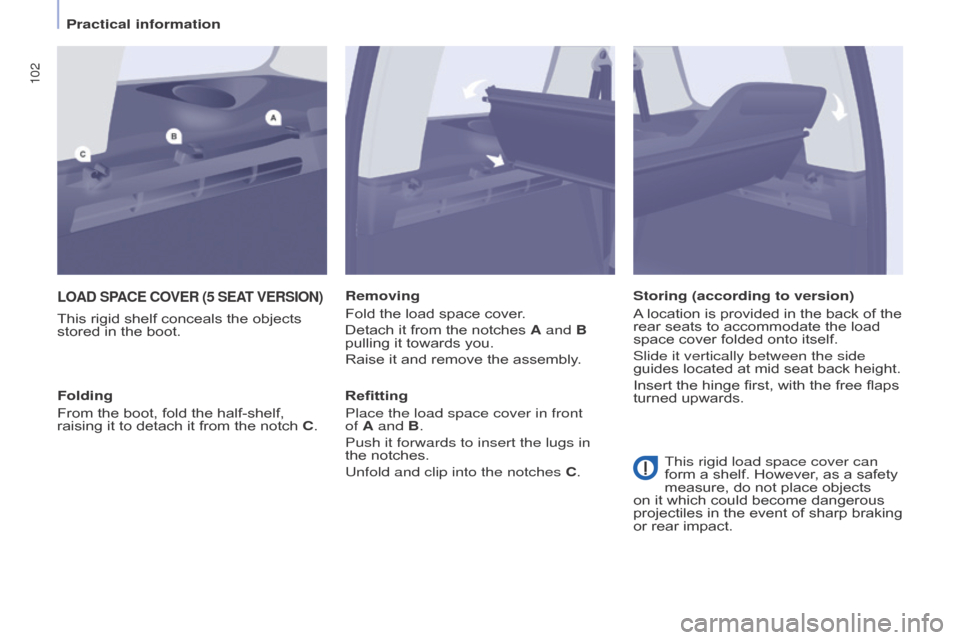
102
Berlingo-2-VP_en_Chap04_Ergonomie_ed01-2015Berlingo-2-VP_en_Chap04_Ergonomie_ed01-2015
LOAD SPACE COVER (5 SEAT VERSION)
This rigid shelf conceals the objects stored in the boot. Removing
Fold
the load space cover.
Detach it from the notches A and B
pulling
it towards you.
Raise
it and remove the assembly.
Refitting
Place the load space cover in front
of A and B.
Push it forwards to insert the lugs in
the
notches.
Unfold and clip into the notches C.
Folding
From
the boot, fold the half-shelf,
raising
it to detach it from the notch C. Storing (according to version)
A
location is provided in the back of the rear
seats to accommodate the load
space
cover folded onto itself.
Slide it vertically between the side
guides
located at mid seat back height.
Insert
the hinge first, with the free flaps
turned
upwards.
This rigid load space cover can
form
a shelf. However, as a safety
measure,
do not place objects
on
it which could become dangerous
projectiles
in the event of sharp braking
or
rear impact.
Practical information
Page 105 of 298
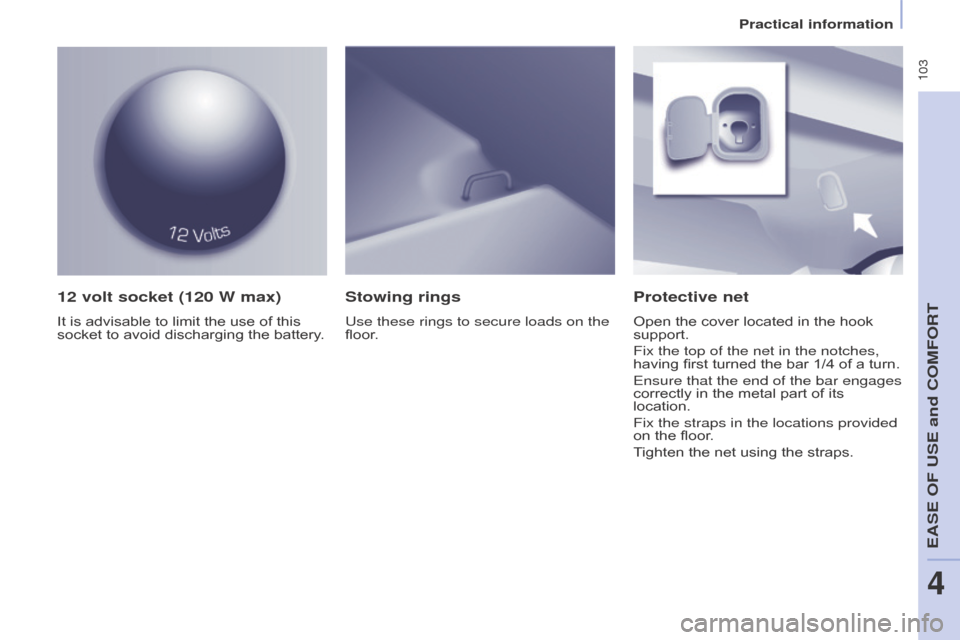
103
Berlingo-2-VP_en_Chap04_Ergonomie_ed01-2015Berlingo-2-VP_en_Chap04_Ergonomie_ed01-2015
12 volt socket (120 W max)
It is advisable to limit the use of this socket to avoid discharging the battery.
Protective net
Open the cover located in the hook support.
Fix the top of the net in the notches,
having
first turned the bar 1/4 of a turn.
Ensure that the end of the bar engages
correctly
in the metal part of its
location.
Fix the straps in the locations provided
on
the floor.
Tighten
the net using the straps.
Stowing rings
Use these rings to secure loads on the
floor.
EaSE oF USE and CoMFoRT
4
Practical information
Page 106 of 298
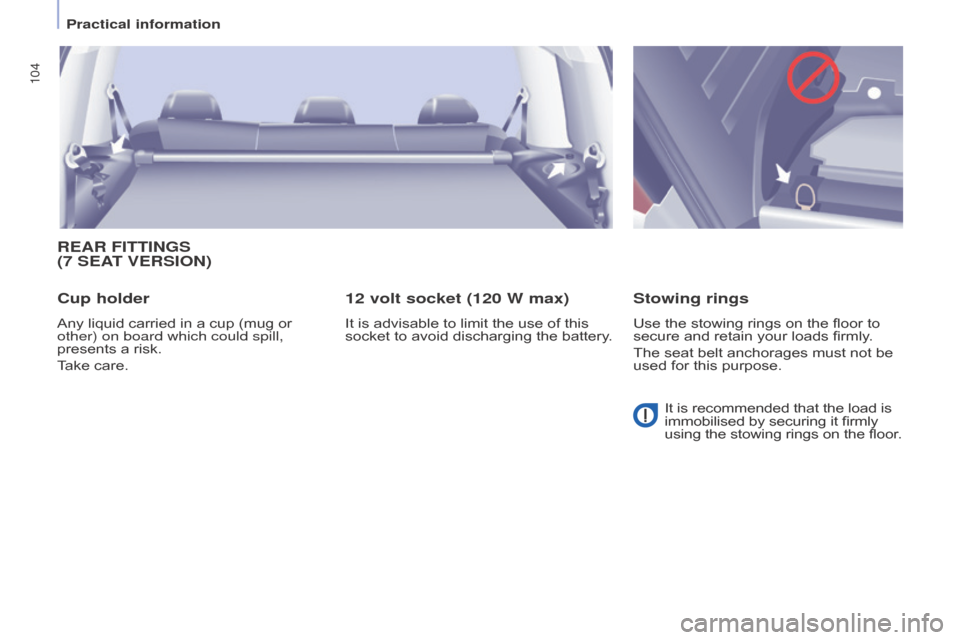
104
Berlingo-2-VP_en_Chap04_Ergonomie_ed01-2015Berlingo-2-VP_en_Chap04_Ergonomie_ed01-2015
REAR FITTINGS
(7 SEAT VERSION )
Cup holder
Any liquid carried in a cup (mug or other) on board which could spill,
presents a risk.
Take
care.
12 volt socket (120 W max)
It is advisable to limit the use of this socket to avoid discharging the battery.
Stowing rings
Use the stowing rings on the floor to secure and retain your loads firmly.
The
seat belt anchorages must not be
used
for this purpose.
It
is recommended that the load is
immobilised
by securing it firmly
using
the stowing rings on the floor.
Practical information
Page 108 of 298

106
Berlingo-2-VP_en_Chap04_Ergonomie_ed01-2015Berlingo-2-VP_en_Chap04_Ergonomie_ed01-2015
BLIND, LOAD SPACE COVER
Position the load space screen so as to
present the rear load space cover flaps
towards
you.
Engage the left-hand lug of the roller in
the support A.
The load space cover is the roller blind
type.
T
ake
care
not
to
place
heavy
objects
on
the
load
space
cover
when
unreeled.
Compress
then place the right-hand lug facing the support
B.
Release to engage the roller in its
support.
Unroll the load space cover to the rear
side
pillars.
Engage the ends in the rear notches to
keep
it taut.
To install it
Place the row 3 seats in the fully folded
position.
Raise
the
storage
flap
at
the
boot
sill.
Take
hold
of
the
roller
in
the
centre
and
compress
it
towards
the
left-hand
pillar.
Raise
the
assembly.
Practical information